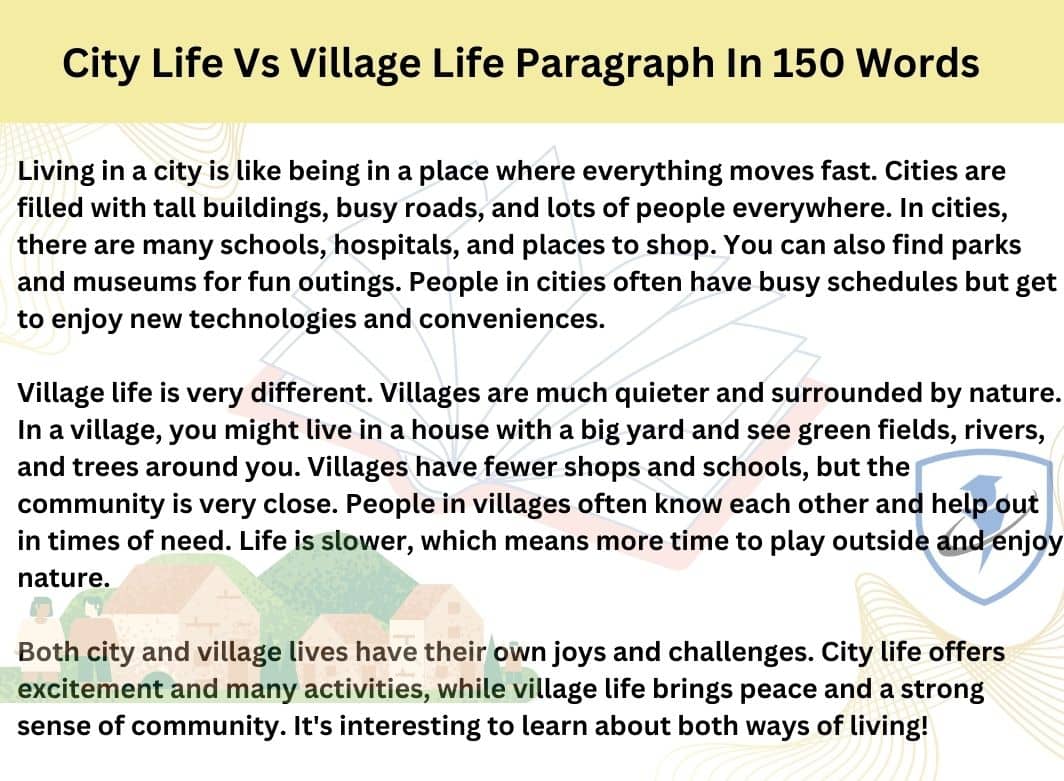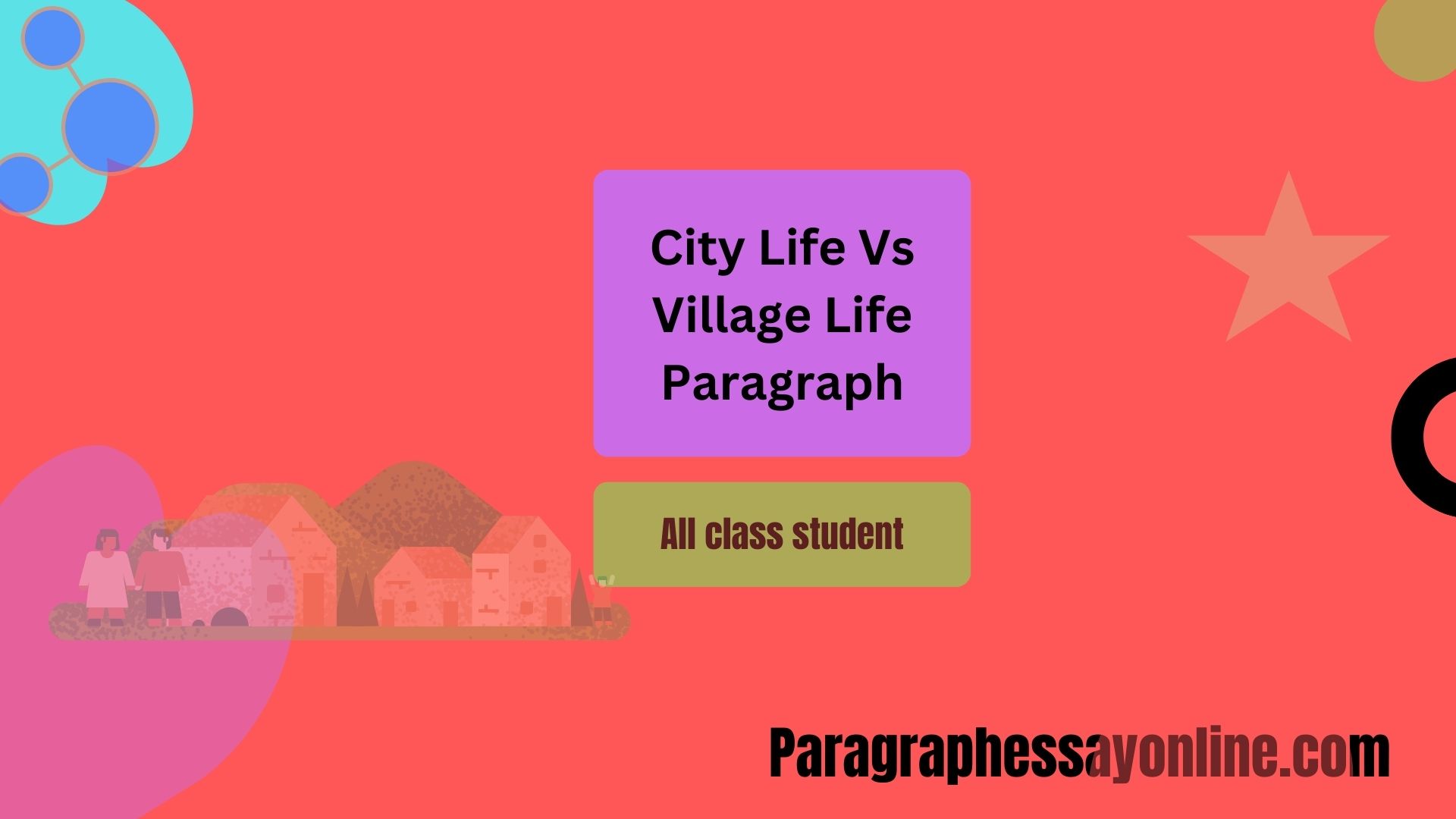City Life Vs Village Life Paragraph
City Life Vs Village Life Paragraph For All Class (100- 500 words)
City life and village life in India present two distinct worlds. City life buzzes with modernity, opportunities, and conveniences, attracting people with its fast-paced lifestyle.
In contrast, village life offers simplicity, close-knit communities, and a connection to nature, embodying India’s rich traditions. Both lifestyles have their unique charms and challenges, reflecting India’s diversity. Choosing between them depends on individual preferences for pace, convenience, and cultural values.
City Life Vs Village Life Paragraph 100 words For Children
City life and village life are like two different worlds. In cities, you’ll find tall buildings, lots of cars, and busy streets. People rush around, going to work or school, and there’s always something happening. Cities have big shops, cinemas, and lots of fun places to visit.
Village life is much quieter. Villages have fewer houses and lots of open spaces like fields and forests. People in villages know each other well and often help out their neighbors.
Both city and village life are special. Cities are exciting and full of adventures, while villages are peaceful and close to nature. It’s nice to experience both!

City Life Vs Village Life Paragraph 150 words For 4 and 5 Students
Living in a city is like being in a place where everything moves fast. Cities are filled with tall buildings, busy roads, and lots of people everywhere. In cities, there are many schools, hospitals, and places to shop. You can also find parks and museums for fun outings. People in cities often have busy schedules but get to enjoy new technologies and conveniences.
Village life is very different. Villages are much quieter and surrounded by nature. In a village, you might live in a house with a big yard and see green fields, rivers, and trees around you. Villages have fewer shops and schools, but the community is very close.
Both city and village lives have their own joys and challenges. City life offers excitement and many activities, while village life brings peace and a strong sense of community. It’s interesting to learn about both ways of living!

City Life Vs Village Life Paragraph 200 words For 6, 7, and 8 Students
Living in a city means being part of a bustling environment where the pace of life is quick. Cities are known for their skyscrapers, wide variety of shops, and busy streets filled with people from all walks of life.
Here, you can access advanced education and healthcare facilities, enjoy cultural activities like theater and art exhibitions, and benefit from the latest technological advancements. Public transport makes getting around easier, and there’s always something new to discover.
Contrastingly, village life is characterized by its serene environment and close-knit communities. Villages are surrounded by natural beauty, from green fields to clear streams, offering a peaceful lifestyle. The slower pace allows residents to form strong bonds with their neighbors, creating a supportive and interconnected community.
Educational and medical facilities might be more limited, but the quality of life is enriched by traditions and a direct connection to nature.
Each lifestyle has its own set of benefits and drawbacks. City life offers convenience and opportunities for personal and professional growth, while village life provides a sense of belonging and a healthier, more relaxed environment. Choosing between the two depends on what values and experiences one seeks in life.
Paragraph On City Life Vs Village Life 250 words For 8,9,10 Students
City living is dynamic and full of opportunities. In a city, life moves fast with its crowded streets, towering buildings, and bustling markets. Cities are hubs of education, healthcare, and employment, offering a wide array of services and amenities like libraries, hospitals, and sports facilities. The cultural diversity in cities is vast, with people from different backgrounds coming together, bringing their traditions and cuisines.
This environment fosters innovation and creativity, offering a broad spectrum of social activities and entertainment options. Life moves at a slower pace, and you can see lots of stars at night because it’s not as bright as the city.
In contrast, village life is marked by its tranquility and simplicity. Villages are nestled in nature, surrounded by lush landscapes and wildlife, offering a healthy, pollution-free environment. Life in a village is slower, allowing people to appreciate the simple joys and maintain strong family ties.
Communities in villages are tightly-knit, with neighbors often sharing resources and celebrating festivals together. Although villages may lack some of the conveniences and facilities found in cities, they offer a rich experience of cultural traditions and a connection to the earth.
While city life is characterized by its fast-paced nature and modern conveniences, village life stands out for its peaceful environment and strong community bonds. Both offer unique experiences and learning opportunities, influencing one’s lifestyle and worldview.
The choice between city and village life depends on individual preferences, with each offering distinct advantages and challenges.
Paragraph On City Life Vs Village Life 300 words For 9, 10, 11, 12 Students
Urban living offers a fast-paced, vibrant environment where innovation, convenience, and diversity converge. Cities, with their sprawling infrastructure, provide residents with unparalleled access to educational institutions, healthcare facilities, and employment opportunities. The cultural vibrancy of cities is unmatched, hosting an array of museums, theaters, concerts, and exhibitions that showcase both global and local talents.
Urban areas are melting pots of cultures, where diverse communities contribute to a rich social tapestry, offering an array of culinary delights, festivals, and traditions. This dynamic setting fosters a spirit of innovation and a wide range of recreational and leisure activities, making city life appealing for those seeking personal and professional growth.
Conversely, village life is synonymous with tranquility, natural beauty, and a strong sense of community. Villages offer a serene backdrop, far removed from the pollution and noise of urban areas, allowing residents to live in harmony with nature. Life here moves at a gentler pace, facilitating deep connections with family and the surrounding community.
The disparity between city and village life also extends to the challenges each environment faces. Urban areas struggle with issues such as pollution, traffic congestion, and social isolation, despite their technological advancements and conveniences.
Villages often preserve traditional ways of life, offering a unique perspective on cultural heritage and sustainability. Although amenities and services may be more limited compared to cities, the emphasis on community support and the integration of agricultural practices enrich the lives of village residents.
The choice between city and village life reflects one’s values and aspirations. Urban areas offer a broad spectrum of opportunities and conveniences, while rural settings offer a peaceful, community-oriented lifestyle.
Each environment provides distinct advantages and experiences, shaping individuals’ lifestyles and worldviews. Ultimately, this choice influences personal development, offering diverse pathways for learning, growth, and community engagement.
City Life Vs Village Life Paragraph 500 Words
Living in a city versus a village presents a spectrum of experiences, shaped by the environment, community, and pace of life. Urban areas, characterized by their bustling streets, towering skyscrapers, and vibrant nightlife, offer a dynamic and fast-paced lifestyle. The city is a melting pot of cultures, bringing together people from diverse backgrounds and creating a rich tapestry of experiences.
Here, innovation and convenience are at every corner, with technology and modern facilities enhancing daily life. Cities boast superior educational institutions, cutting-edge healthcare services, and a plethora of employment opportunities across various industries. This environment fosters personal and professional growth, making cities attractive to those seeking to advance their careers and education.
Moreover, cities are cultural hubs, hosting an array of museums, theaters, galleries, and concerts, providing residents with endless entertainment and learning opportunities. The culinary scene in urban areas is diverse, offering everything from street food to high-end dining, representing cuisines from all over the world. Urban living also encourages independence and individualism, with people leading busy lives, often focusing on personal achievements and goals.
In contrast, village life is imbued with simplicity, tranquility, and a close-knit community atmosphere. Villages, set amidst nature, offer a serene and healthy environment, away from the pollution and noise of urban areas. Life in a village moves at a slower pace, allowing residents to form deep connections with each other and their surroundings.
Villages maintain a strong sense of tradition and cultural heritage, with communal activities and festivals playing a central role in daily life. The support system in villages is robust, with neighbors readily offering help, creating a strong sense of belonging and community.
Agricultural practices and a direct connection to nature define village life, with many residents involved in farming and natural crafts. This lifestyle promotes sustainability and a deep appreciation for the earth’s resources.
The high cost of living and competitive nature of cities can lead to stress and a sense of alienation among residents. Conversely, villages face challenges related to limited access to healthcare, education, and modern amenities, which can hinder personal development and access to global opportunities.
Both urban and rural lifestyles have their unique advantages and drawbacks. City life, with its access to diverse opportunities, fosters a sense of independence and ambition. It caters to those seeking a vibrant social life, career advancement, and cultural experiences.
On the other hand, village life offers a peaceful, community-oriented existence, deeply connected to nature and traditional values. It appeals to those who prioritize family, community, and a simpler way of living.
The choice between city and village life reflects an individual’s priorities, values, and aspirations. While urban areas offer a pathway to innovation, diversity, and progress, rural settings provide a retreat to simplicity, community, and nature.
Each lifestyle presents a unique set of experiences, challenges, and rewards, shaping individuals’ perspectives and life choices. In the end, whether one prefers the bustling streets of a city or the tranquil paths of a village, both environments contribute to the rich mosaic of human experience, offering distinct paths to fulfillment and happiness.
More Paragraphs:
| My Favourite Book Paragraph. |
| Arsenic Pollution Paragraph. |
| National Memorial Paragraph. |
| Truthfulness Paragraph. |
| My Ambition In Life Paragraph. |
Paragraph On City Life Vs Village Life FAQs
Q: Is education better in cities or villages?
Answer: Generally, cities offer more advanced educational facilities, resources, and opportunities due to the availability of various schools, colleges, and universities equipped with modern technology.
Q: Which is healthier, city life or village life?
Answer: Village life tends to be healthier due to less pollution, more green spaces, and a closer connection to nature, leading to a more active lifestyle and fresher food options.
Q: Can you find job opportunities in villages?
Answer: While job opportunities in villages are growing, especially in agribusiness, handicrafts, and eco-tourism, cities still offer a wider range of employment options across different industries.
Q: How do social relationships compare between city and village life?
Answer: In villages, social relationships are often stronger due to the close-knit community where everyone knows each other. Cities offer more anonymity but provide opportunities to meet a diverse range of people.
